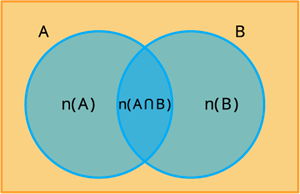
PUMPA - SMART LEARNING
எங்கள் ஆசிரியர்களுடன் 1-ஆன்-1 ஆலோசனை நேரத்தைப் பெறுங்கள். டாப்பர் ஆவதற்கு நாங்கள் பயிற்சி அளிப்போம்
Book Free DemoCardinality of the Union of Two Sets: Consider two sets \(A\) and \(B\), and their union \(A∪ B\). We want to count the number of elements in the union; that is, to calculate \(n(A∪ B)\). It seems sensible to count the elements in \(A\), and then count the elements in \(B\), and add the two quantities together. However, there is the possibility that some elements have been counted twice, specifically, those elements that lie in both sets \(A\) and \(B\) simultaneously – the intersection \(A∩ B\). To balance this over-count, we subtract the number of elements in the intersection.

The result is a useful formula called the cardinal of the union: .
Let \(A =\) \(1\), \(2\), \(3\) and \(B =\) \(2\), \(4\), \(6\), \(7\). Calculate the number of elements in the union \(A∪B\).
Set \(A\) has \(3\) elements and set \(B\) has \(4\) elements, so we write \(n(A) = 3\) and \(n(B) = 4\).
\(A∩B = A =\) \(1\), \(2\), \(3\) \(∩ B =\) \(2\), \(4\), \(6\), \(7\) \(=\) \(2\).
The set \(A∩B\) has \(1\) element, so we write \((A∩B) = 1\)
The formula then gives:
\(n(A∪B)\) \(=\) \(3 + 4 - 1\)
\(n(A∪B)\) \(=\) \(7 - 1\)
\(n(A∪B)\) \(=\) \(6\)
Hence there are \(6\) elements in the union. By observation, we see that it is true.
\(A∪B =\) \(1\), \(2\), \(3\) \(∪\) \(2\), \(4\), \(6\), \(7\)
In this, the common elements being taken only once.
\((A∪B) =\) \(1\), \(2\), \(3\), \(4\), \(6\), \(7\) which contains \(6\) elements.
- ;
- ;
- .
Important!